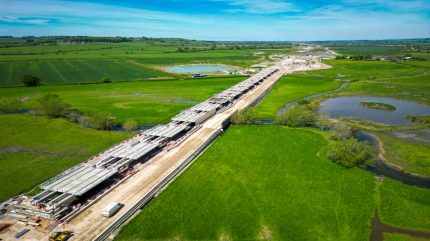
The construction of High Speed Two (HS2)’s Thame Valley Viaduct in the UK has successfully passed the halfway point, marking a major milestone for the development.
Spanning the floodplain of the River Thame, the 880m viaduct will support HS2 trains travelling at speeds of up to 225mph between London and Birmingham.
The project, located near Aylesbury, has seen 44 of its 72 customised precast beams positioned and 66 of the 70 piers installed.
The design team, inspired by Spanish high-speed rail viaducts, has implemented a simple structural solution using two large hollow U-shaped beams per span.
These are produced nearly 85 miles away on the Isle of Grain in Kent.
This approach eliminates the need for concrete to be poured on site, as well as reduces the carbon footprint of the structure by approximately one-third.
The viaduct has been designed with a low profile, standing 3m above the ground, ensuring that HS2 services can continue operating even during heavy rain and flooding.
HS2 main works contractor EKFB, which is a collaboration between Eiffage, Kier, Ferrovial Construction, and BAM Nuttall, designed the viaduct.
FC Civils Solutions served as the specialist on-site construction partner.
The larger precast beams used at the site are said to have been secured directly to one another, speeding up the work with up to six 90-tonne beams being installed each week.
Once in place, specialist teams are noted to begin threading steel bars between the beams and post-tensioning them to provide the necessary structural strength for the high-speed trains.
Additionally, the Kent-based factory produced the parapets and concrete planks for the deck supporting the tracks.


